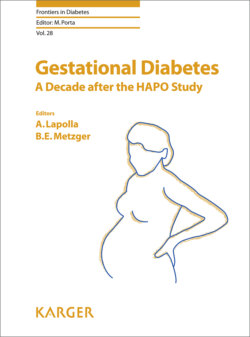Читать книгу Gestational Diabetes - Группа авторов - Страница 55
На сайте Литреса книга снята с продажи.
HAPO Study
ОглавлениеThe clinical significance of GDM is related first and foremost to short-term perinatal complications, rather than to future development of maternal diabetes. Thus, the diagnostic values of O’Sullivan’s criteria – and all guidelines following it – are of limited value. Multiple studies have suggested that glucose values that attribute to less favorable perinatal outcome are lower than expected [10–17]. In order to establish the evidence base for the diagnosis of GDM, the HAPO study was initiated, aiming to provide the evidence for GDM diagnostic criteria and to clarify relationship between maternal HAPO [18]. HAPO was a prospective, observational, multicenter, blinded clinical trial. Approximately 25,000 women were recruited; each performed a 2-h 75 g OGTT at 24–28 gestational weeks. The results demonstrated a linear association between increasing levels of fasting, 1-, and 2-h plasma glucose post a 75 g OGTT, to all 4 primary end points of the study: large for gestational age (LGA), cord blood C-peptide, cesarean delivery, and neonatal hypoglycemia. Positive linear correlations were also found to the 5 secondary outcomes: preterm birth, preeclampsia, shoulder dystocia or birth injury, NICU admission, and hyperbilirubinemia.
Table 3. Strategy for the detection and diagnosis of hyperglycemia in pregnancy
The results of the HAPO study were supported by other reports of a continuous association between hyperglycemia to LGA newborns, macrosomia, cesarean delivery, preterm birth, shoulder dystocia, neonatal hypoglycemia, and hyperbilirubinemia [19–21].
Following the primary publication of the HAPO study, several secondary analyses [22–31] demonstrated other key findings: maternal hyperglycemia, C-peptide, and body mass index (BMI) are associated with preeclampsia [22]; maternal hyperglycemia and cord C-peptide are associated with neonatal adiposity [23]; BMI, independent of maternal glycemia, is associated with adverse pregnancy outcome, particularly, LGA, adiposity, and preeclampsia [24]; GDM and obesity are independently associated with adverse pregnancy outcomes and their combination has a greater impact than either one alone [25]; and biochemical and clinical neonatal hypoglycemia are weakly related to OGTT glucose measurements, but strongly associated with cord C-peptide [26].
The HAPO was a clinical trial, and was the basis for the IADPSG, aiming to convert the results of the HAPO into practical guidelines, as was done only once, >50 years earlier, with O’Sullivan’s data.
